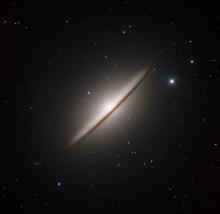Listen to today's episode of StarDate on the web the same day it airs in high-quality streaming audio without any extra ads or announcements. Choose a $8 one-month pass, or listen every day for a year for just $30.
You are here
Repeating a Meal
Astronomers usually look for things to get bright. But this month, they’re looking for a black hole in a distant galaxy to get dark — the result of a break in the black hole’s dinner.
The black hole is about 50 million times the mass of the Sun. It’s getting a little heavier by eating a nearby star. And it appears to refill its plate every 3.3 years.
That situation is rare. Astronomers do see black holes ripping stars apart. But in almost every case, it’s a one-time feast — the black hole completely destroys the star.
But in the case of AT 2018ftk, astronomers have seen a couple of outbursts. A recent study says the star survived the first pass, and is making repeated encounters, losing some of its gas each time.
The star probably had a close companion. They were ripped away from each other by the black hole’s gravity. The companion star was kicked away fast enough to escape the galaxy.
The other star swung into a lopsided orbit around the black hole. Each pass pulls away more of the star’s gas, which spirals into the black hole. The gas gets extremely hot, so it emits X-rays. It stays bright for about half of the star’s orbit, then goes dark, which should happen this month — a disruption in the black hole’s dinner.
AT 2018ftk is in Grus, the crane. For skywatchers in the southern half of the U.S., the constellation stands quite low in the south in the wee hours of the morning.
Script by Damond Benningfield





